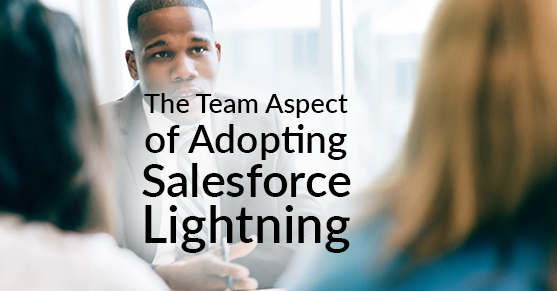We’ve talked about the beneficial features of Lightning and the technical details of migrating, but there’s another important aspect: your team. Adopting Lightning isn’t just about turning on a switch; it’s about having a unified vision and synchronizing the initiatives of a strong, focused team.
When you start transitioning to Lightning (or if you’re still evaluating whether or not you’ll commit to it), it’s important to identify the right team members to support the rollout. Not only are the members important, but their input and commitment are paramount to truly benefiting from and Lightning. Before migrating, it’s important to identify two things: an executive sponsor and primary stakeholders.
As with any business initiative, you’ll need executive support and buy-in to help drive the transition. Without an executive sponsor, you might not get the company alignment and resource allocation needed to succeed. Once an executive has invested in Lightning, the next step is to organize a team of project members from across business units to gain traction. For example, you’ll want to involve your Sales managers, team members from Sales Operations, Salesforce admins, and a superuser group.
With executive support, a strong team, and the drive to improve your Salesforce experience, it’s time to strategize. Open the floor for involvement, opinions, and ideas to assess the technical readiness of your business and the best possible way to roll out Lightning. Some questions your team might want to answer include:
- By migrating to Lightning, how can we streamline areas of our business? How can Lightning improve processes and user experience?
- How will our current applications and Salesforce features/customizations work in Lightning? What all will change and how will we handle potential disruptions?
- What all is required of us before we transition? What work needs to get done? Who will do it? And, what is our timeline for making all of this happen?
One of the most important questions you’ll be trying answer throughout this whole process is, “how is Lightning going to help us sell more?” It’s not an easy question to answer — especially when the ones asking are attached to Classic or “their way” of doing things — but your project team will be ready to answer.
Brainstorming around those questions will put your business in a better position to adopt Lightning. Understanding how Lightning will improve business processes will help you get buy-in from the various departments of your organization. They may be skeptical, as most people will feel more comfortable using Classic, but knowing the disruptions and workarounds will help soothe their concern. And, by knowing the requirements and timeline, you’ll be able to put an exact date on when and how you’ll implement Lightning to your entire business.
Switching to the Lightning interface doesn’t just mean flicking a switch; it’s a process — both technical and social — of collaboration between departments and teams to create a sense of technical readiness and a unified vision of success. As with most change, there will undoubtedly be some drawback among employees, but taking a tactical approach will help you prepare to open their eyes to the benefits of Lightning. More than likely, they’ll come to love the new interface.
If you’d like more information on how your business can benefit from transitioning to the Lightning Experience, read our other blogs on Lightning migration, or feel free to reach out to us. At remoteCRM, powered by XTIVIA, our team of Certified Salesforce experts can help you with all your Lightning needs. We’ll partner with you to strategize and plan a migration project, as well as provide exceptional training and ongoing coaching so you always get the most out of your Salesforce platform.

